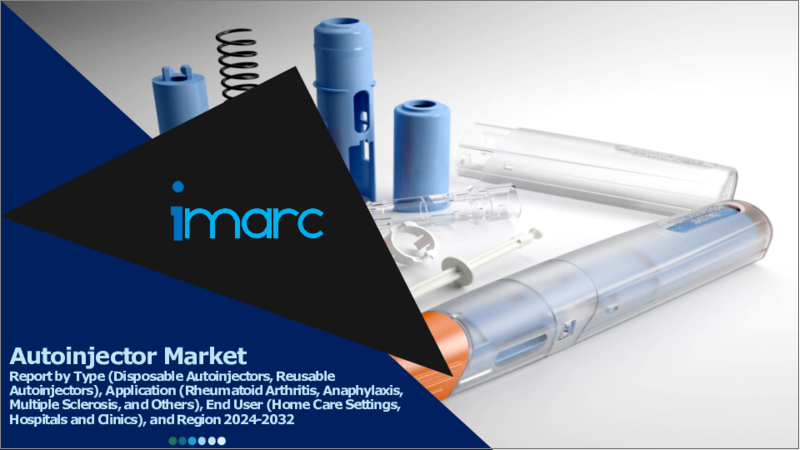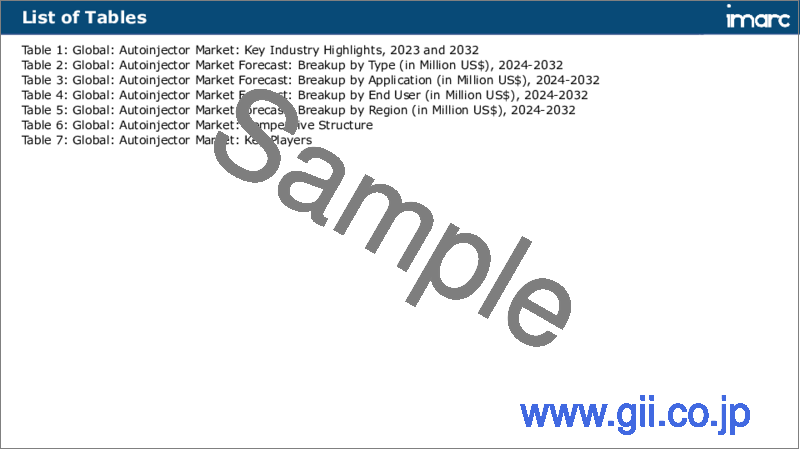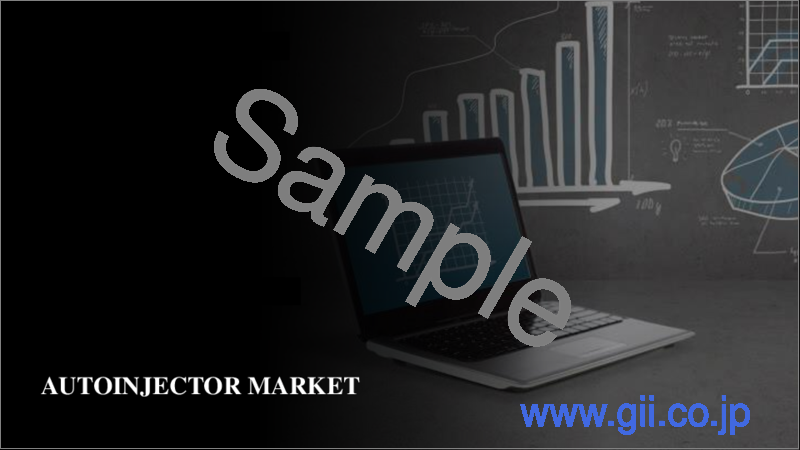|
|
市場調査レポート
商品コード
1521201
オートインジェクター市場レポート:タイプ、用途、エンドユーザー、地域別、2024年~2032年Autoinjector Market Report by Type (Disposable Autoinjectors, Reusable Autoinjectors), Application (Rheumatoid Arthritis, Anaphylaxis, Multiple Sclerosis, and Others), End User (Home Care Settings, Hospitals and Clinics), and Region 2024-2032 |
||||||
カスタマイズ可能
|
|||||||
| オートインジェクター市場レポート:タイプ、用途、エンドユーザー、地域別、2024年~2032年 |
|
出版日: 2024年07月01日
発行: IMARC
ページ情報: 英文 149 Pages
納期: 2~3営業日
|
- 全表示
- 概要
- 図表
- 目次
世界のオートインジェクターの市場規模は2023年に22億米ドルに達しました。今後、IMARC Groupは、市場は2032年までに74億米ドルに達し、2024年から2032年の間に13.9%の成長率(CAGR)を示すと予測しています。
オートインジェクターは、皮下または筋肉内経路で薬剤を送達する自己注射器です。投与量の正確性や患者のコンプライアンス向上など、いくつかの利点があり、患者の注射針恐怖症の軽減、注射針が隠れたことによる針刺し傷害の減少、ヘルスケア専門家の利便性と効率の向上に役立ちます。アナフィラキシー、片頭痛、てんかん重積状態、乾癬、糖尿病、多発性硬化症、関節リウマチなどの緊急時に広く使用されています。その結果、オートインジェクターは世界中の病院、診療所、在宅ケアセンターで幅広く使用されています。
オートインジェクター市場動向:
現在、関節炎、喘息、がん、慢性閉塞性肺疾患(COPD)、アルツハイマー病の有病率が上昇しています。これは、自己投与医薬品に対するニーズの高まりとともに、市場を牽引する重要な要因の一つとなっています。さらに、いくつかの国の政府は、学校でのオートインジェクターの使用を促進するためのイニシアチブを実施しています。これは、自己注射器の利点に関する個人の意識の高まりと相まって、市場の成長を推進しています。さらに、主な市場開拓者は、関節リウマチや多発性硬化症の治療のために、シンプルで費用対効果の高い新技術ベースの自己注射器を開発するために、研究開発(R&D)活動に幅広く投資しています。これに加えて、がん細胞内のタンパク質を変化させ、腫瘍内の新生血管の形成を防ぐ標的療法の採用が増加しており、業界の投資家に有利な成長機会を提供しています。さらに、世界中でヘルスケア産業が急成長していることも、市場の成長を後押ししています。成長を促すその他の要因としては、規制当局の承認数の増加、技術の進歩、生物製剤の特許切れ、オートインジェクターのジェネリックバージョンの入手可能性などが挙げられます。
本レポートで扱う主な質問
- 2023年の世界のオートインジェクター市場の市場規模は?
- 2024-2032年の世界のオートインジェクター市場の予想成長率は?
- 世界のオートインジェクター市場を牽引する主な要因は?
- 世界のオートインジェクター市場に対するCOVID-19の影響は?
- 世界のオートインジェクター市場のタイプ別内訳は?
- 世界のオートインジェクター市場の用途別内訳は?世界のオートインジェクター市場のエンドユーザー別内訳は?
- 世界のオートインジェクター市場の主要地域は?
- 世界のオートインジェクター市場の主要プレーヤー/企業は?
目次
第1章 序文
第2章 調査範囲と調査手法
- 調査の目的
- ステークホルダー
- データソース
- 一次情報
- 二次情報
- 市場推定
- ボトムアップアプローチ
- トップダウンアプローチ
- 調査手法
第3章 エグゼクティブサマリー
第4章 イントロダクション
- 概要
- 主要業界動向
第5章 世界のオートインジェクター市場
- 市場概要
- 市場実績
- COVID-19の影響
- 市場予測
第6章 市場内訳:タイプ別
- 使い捨てオートインジェクター
- 市場動向
- 市場予測
- 再利用可能なオートインジェクター
- 市場動向
- 市場予測
第7章 市場内訳:用途別
- 関節リウマチ
- 市場動向
- 市場予測
- アナフィラキシー
- 市場動向
- 市場予測
- 多発性硬化症
- 市場動向
- 市場予測
- その他
- 市場動向
- 市場予測
第8章 市場内訳:エンドユーザー別
- ホームケア設定
- 市場動向
- 市場予測
- 病院と診療所
- 市場動向
- 市場予測
第9章 市場内訳:地域別
- 北米
- 米国
- カナダ
- アジア太平洋地域
- 中国
- 日本
- インド
- 韓国
- オーストラリア
- インドネシア
- その他
- 欧州
- ドイツ
- フランス
- 英国
- イタリア
- スペイン
- ロシア
- その他
- ラテンアメリカ
- ブラジル
- メキシコ
- その他
- 中東・アフリカ
- 市場動向
- 市場内訳:国別
- 市場予測
第10章 SWOT分析
- 概要
- 強み
- 弱み
- 機会
- 脅威
第11章 バリューチェーン分析
第12章 ポーターのファイブフォース分析
- 概要
- 買い手の交渉力
- 供給企業の交渉力
- 競合の程度
- 新規参入業者の脅威
- 代替品の脅威
第13章 価格分析
第14章 競合情勢
- 市場構造
- 主要企業
- 主要企業のプロファイル
- Amgen Inc.
- Antares Pharma Inc.
- Becton Dickinson and Company
- Bristol-Myers Squibb Company
- Eisai Co. Ltd.
- Eli Lilly and Company
- Haselmeier GmbH(Sulzer Ltd.)
- Johnson & Johnson
- Mylan N.V.(Viatris Inc.)
- Novartis AG
- SHL Medical AG
- Teva Pharmaceutical Industries Ltd.
- Ypsomed Holding AG
List of Figures
- Figure 1: Global: Autoinjector Market: Major Drivers and Challenges
- Figure 2: Global: Autoinjector Market: Sales Value (in Billion US$), 2018-2023
- Figure 3: Global: Autoinjector Market Forecast: Sales Value (in Billion US$), 2024-2032
- Figure 4: Global: Autoinjector Market: Breakup by Type (in %), 2023
- Figure 5: Global: Autoinjector Market: Breakup by Application (in %), 2023
- Figure 6: Global: Autoinjector Market: Breakup by End User (in %), 2023
- Figure 7: Global: Autoinjector Market: Breakup by Region (in %), 2023
- Figure 8: Global: Autoinjector (Disposable Autoinjectors) Market: Sales Value (in Million US$), 2018 & 2023
- Figure 9: Global: Autoinjector (Disposable Autoinjectors) Market Forecast: Sales Value (in Million US$), 2024-2032
- Figure 10: Global: Autoinjector (Reusable Autoinjectors) Market: Sales Value (in Million US$), 2018 & 2023
- Figure 11: Global: Autoinjector (Reusable Autoinjectors) Market Forecast: Sales Value (in Million US$), 2024-2032
- Figure 12: Global: Autoinjector (Rheumatoid Arthritis) Market: Sales Value (in Million US$), 2018 & 2023
- Figure 13: Global: Autoinjector (Rheumatoid Arthritis) Market Forecast: Sales Value (in Million US$), 2024-2032
- Figure 14: Global: Autoinjector (Anaphylaxis) Market: Sales Value (in Million US$), 2018 & 2023
- Figure 15: Global: Autoinjector (Anaphylaxis) Market Forecast: Sales Value (in Million US$), 2024-2032
- Figure 16: Global: Autoinjector (Multiple Sclerosis) Market: Sales Value (in Million US$), 2018 & 2023
- Figure 17: Global: Autoinjector (Multiple Sclerosis) Market Forecast: Sales Value (in Million US$), 2024-2032
- Figure 18: Global: Autoinjector (Other Applications) Market: Sales Value (in Million US$), 2018 & 2023
- Figure 19: Global: Autoinjector (Other Applications) Market Forecast: Sales Value (in Million US$), 2024-2032
- Figure 20: Global: Autoinjector (Home Care Settings) Market: Sales Value (in Million US$), 2018 & 2023
- Figure 21: Global: Autoinjector (Home Care Settings) Market Forecast: Sales Value (in Million US$), 2024-2032
- Figure 22: Global: Autoinjector (Hospitals and Clinics) Market: Sales Value (in Million US$), 2018 & 2023
- Figure 23: Global: Autoinjector (Hospitals and Clinics) Market Forecast: Sales Value (in Million US$), 2024-2032
- Figure 24: North America: Autoinjector Market: Sales Value (in Million US$), 2018 & 2023
- Figure 25: North America: Autoinjector Market Forecast: Sales Value (in Million US$), 2024-2032
- Figure 26: United States: Autoinjector Market: Sales Value (in Million US$), 2018 & 2023
- Figure 27: United States: Autoinjector Market Forecast: Sales Value (in Million US$), 2024-2032
- Figure 28: Canada: Autoinjector Market: Sales Value (in Million US$), 2018 & 2023
- Figure 29: Canada: Autoinjector Market Forecast: Sales Value (in Million US$), 2024-2032
- Figure 30: Asia-Pacific: Autoinjector Market: Sales Value (in Million US$), 2018 & 2023
- Figure 31: Asia-Pacific: Autoinjector Market Forecast: Sales Value (in Million US$), 2024-2032
- Figure 32: China: Autoinjector Market: Sales Value (in Million US$), 2018 & 2023
- Figure 33: China: Autoinjector Market Forecast: Sales Value (in Million US$), 2024-2032
- Figure 34: Japan: Autoinjector Market: Sales Value (in Million US$), 2018 & 2023
- Figure 35: Japan: Autoinjector Market Forecast: Sales Value (in Million US$), 2024-2032
- Figure 36: India: Autoinjector Market: Sales Value (in Million US$), 2018 & 2023
- Figure 37: India: Autoinjector Market Forecast: Sales Value (in Million US$), 2024-2032
- Figure 38: South Korea: Autoinjector Market: Sales Value (in Million US$), 2018 & 2023
- Figure 39: South Korea: Autoinjector Market Forecast: Sales Value (in Million US$), 2024-2032
- Figure 40: Australia: Autoinjector Market: Sales Value (in Million US$), 2018 & 2023
- Figure 41: Australia: Autoinjector Market Forecast: Sales Value (in Million US$), 2024-2032
- Figure 42: Indonesia: Autoinjector Market: Sales Value (in Million US$), 2018 & 2023
- Figure 43: Indonesia: Autoinjector Market Forecast: Sales Value (in Million US$), 2024-2032
- Figure 44: Others: Autoinjector Market: Sales Value (in Million US$), 2018 & 2023
- Figure 45: Others: Autoinjector Market Forecast: Sales Value (in Million US$), 2024-2032
- Figure 46: Europe: Autoinjector Market: Sales Value (in Million US$), 2018 & 2023
- Figure 47: Europe: Autoinjector Market Forecast: Sales Value (in Million US$), 2024-2032
- Figure 48: Germany: Autoinjector Market: Sales Value (in Million US$), 2018 & 2023
- Figure 49: Germany: Autoinjector Market Forecast: Sales Value (in Million US$), 2024-2032
- Figure 50: France: Autoinjector Market: Sales Value (in Million US$), 2018 & 2023
- Figure 51: France: Autoinjector Market Forecast: Sales Value (in Million US$), 2024-2032
- Figure 52: United Kingdom: Autoinjector Market: Sales Value (in Million US$), 2018 & 2023
- Figure 53: United Kingdom: Autoinjector Market Forecast: Sales Value (in Million US$), 2024-2032
- Figure 54: Italy: Autoinjector Market: Sales Value (in Million US$), 2018 & 2023
- Figure 55: Italy: Autoinjector Market Forecast: Sales Value (in Million US$), 2024-2032
- Figure 56: Spain: Autoinjector Market: Sales Value (in Million US$), 2018 & 2023
- Figure 57: Spain: Autoinjector Market Forecast: Sales Value (in Million US$), 2024-2032
- Figure 58: Russia: Autoinjector Market: Sales Value (in Million US$), 2018 & 2023
- Figure 59: Russia: Autoinjector Market Forecast: Sales Value (in Million US$), 2024-2032
- Figure 60: Others: Autoinjector Market: Sales Value (in Million US$), 2018 & 2023
- Figure 61: Others: Autoinjector Market Forecast: Sales Value (in Million US$), 2024-2032
- Figure 62: Latin America: Autoinjector Market: Sales Value (in Million US$), 2018 & 2023
- Figure 63: Latin America: Autoinjector Market Forecast: Sales Value (in Million US$), 2024-2032
- Figure 64: Brazil: Autoinjector Market: Sales Value (in Million US$), 2018 & 2023
- Figure 65: Brazil: Autoinjector Market Forecast: Sales Value (in Million US$), 2024-2032
- Figure 66: Mexico: Autoinjector Market: Sales Value (in Million US$), 2018 & 2023
- Figure 67: Mexico: Autoinjector Market Forecast: Sales Value (in Million US$), 2024-2032
- Figure 68: Others: Autoinjector Market: Sales Value (in Million US$), 2018 & 2023
- Figure 69: Others: Autoinjector Market Forecast: Sales Value (in Million US$), 2024-2032
- Figure 70: Middle East and Africa: Autoinjector Market: Sales Value (in Million US$), 2018 & 2023
- Figure 71: Middle East and Africa: Autoinjector Market: Breakup by Country (in %), 2023
- Figure 72: Middle East and Africa: Autoinjector Market Forecast: Sales Value (in Million US$), 2024-2032
- Figure 73: Global: Autoinjector Industry: SWOT Analysis
- Figure 74: Global: Autoinjector Industry: Value Chain Analysis
- Figure 75: Global: Autoinjector Industry: Porter's Five Forces Analysis
List of Tables
- Table 1: Global: Autoinjector Market: Key Industry Highlights, 2023 and 2032
- Table 2: Global: Autoinjector Market Forecast: Breakup by Type (in Million US$), 2024-2032
- Table 3: Global: Autoinjector Market Forecast: Breakup by Application (in Million US$), 2024-2032
- Table 4: Global: Autoinjector Market Forecast: Breakup by End User (in Million US$), 2024-2032
- Table 5: Global: Autoinjector Market Forecast: Breakup by Region (in Million US$), 2024-2032
- Table 6: Global: Autoinjector Market: Competitive Structure
- Table 7: Global: Autoinjector Market: Key Players
The global autoinjector market market size reached US$ 2.2 Billion in 2023. Looking forward, IMARC Group expects the market to reach US$ 7.4 Billion by 2032, exhibiting a growth rate (CAGR) of 13.9% during 2024-2032.
Autoinjectors are self-injectable devices that help deliver drugs via the subcutaneous or intramuscular route. They offer several advantages, such as dosage accuracy and improved patient compliance, and help reduce needle phobia of patients, lower needlestick injuries resulting from a hidden needle, and increase the convenience and efficiency of healthcare professionals. They are widely used during emergency conditions, such as anaphylaxis, migraine, status epilepticus, psoriasis, diabetes, multiple sclerosis, and rheumatoid arthritis. As a result, autoinjectors find extensive applications in hospitals, clinics, and home care centers across the globe.
Autoinjector Market Trends:
At present, there is a rise in the prevalence of arthritis, asthma, cancer, chronic obstructive pulmonary disease (COPD) and Alzheimer's disease. This, along with the growing need for self-administrating medicines, represents one of the key factors driving the market. Moreover, governments of several countries are undertaking initiatives to promote the use of autoinjectors in schools. This, coupled with the increasing awareness among individuals about the benefits of autoinjectors, is propelling the growth of the market. In addition, key market players are extensively investing in research and development (R&D) activities to develop simple, cost-effective, and new technology-based autoinjectors for treating rheumatoid arthritis and multiple sclerosis. Besides this, the rising adoption of targeted therapies to alter proteins within cancer cells and prevent the formation of new blood vessels in the tumor is offering lucrative growth opportunities to industry investors. Additionally, the burgeoning healthcare industry around the world is bolstering the growth of the market. Some of the other factors inducing growth are the increasing number of regulatory approvals, technological advancements, patent expiry of biologics and the availability of generic versions of autoinjectors.
Key Market Segmentation:
IMARC Group provides an analysis of the key trends in each sub-segment of the global autoinjector market report, along with forecasts at the global, regional and country level from 2024-2032. Our report has categorized the market based on type, application and end user.
Breakup by Type:
Disposable Autoinjectors
Reusable Autoinjectors
Breakup by Application:
Rheumatoid Arthritis
Anaphylaxis
Multiple Sclerosis
Others
Breakup by End User:
Home Care Settings
Hospitals and Clinics
Breakup by Region:
North America
United States
Canada
Asia-Pacific
China
Japan
India
South Korea
Australia
Indonesia
Others
Europe
Germany
France
United Kingdom
Italy
Spain
Russia
Others
Latin America
Brazil
Mexico
Others
Middle East and Africa
Competitive Landscape:
The competitive landscape of the industry has also been examined along with the profiles of the key players being Amgen Inc., Antares Pharma Inc., Becton Dickinson and Company, Bristol-Myers Squibb Company, Eisai Co. Ltd., Eli Lilly and Company, Haselmeier GmbH (Sulzer Ltd.), Johnson & Johnson, Mylan N.V. (Viatris Inc.), Novartis AG, SHL Medical AG, Teva Pharmaceutical Industries Ltd. and Ypsomed Holding AG.
Key Questions Answered in This Report
- 1. What was the size of the global autoinjector market in 2023?
- 2. What is the expected growth rate of the global autoinjector market during 2024-2032?
- 3. What are the key factors driving the global autoinjector market?
- 4. What has been the impact of COVID-19 on the global autoinjector market?
- 5. What is the breakup of the global autoinjector market based on the type?
- 6. What is the breakup of the global autoinjector market based on the application?
- 7. What is the breakup of the global autoinjector market based on the end user?
- 8. What are the key regions in the global autoinjector market?
- 9. Who are the key players/companies in the global autoinjector market?
Table of Contents
1 Preface
2 Scope and Methodology
- 2.1 Objectives of the Study
- 2.2 Stakeholders
- 2.3 Data Sources
- 2.3.1 Primary Sources
- 2.3.2 Secondary Sources
- 2.4 Market Estimation
- 2.4.1 Bottom-Up Approach
- 2.4.2 Top-Down Approach
- 2.5 Forecasting Methodology
3 Executive Summary
4 Introduction
- 4.1 Overview
- 4.2 Key Industry Trends
5 Global Autoinjector Market
- 5.1 Market Overview
- 5.2 Market Performance
- 5.3 Impact of COVID-19
- 5.4 Market Forecast
6 Market Breakup by Type
- 6.1 Disposable Autoinjectors
- 6.1.1 Market Trends
- 6.1.2 Market Forecast
- 6.2 Reusable Autoinjectors
- 6.2.1 Market Trends
- 6.2.2 Market Forecast
7 Market Breakup by Application
- 7.1 Rheumatoid Arthritis
- 7.1.1 Market Trends
- 7.1.2 Market Forecast
- 7.2 Anaphylaxis
- 7.2.1 Market Trends
- 7.2.2 Market Forecast
- 7.3 Multiple Sclerosis
- 7.3.1 Market Trends
- 7.3.2 Market Forecast
- 7.4 Others
- 7.4.1 Market Trends
- 7.4.2 Market Forecast
8 Market Breakup by End User
- 8.1 Home Care Settings
- 8.1.1 Market Trends
- 8.1.2 Market Forecast
- 8.2 Hospitals and Clinics
- 8.2.1 Market Trends
- 8.2.2 Market Forecast
9 Market Breakup by Region
- 9.1 North America
- 9.1.1 United States
- 9.1.1.1 Market Trends
- 9.1.1.2 Market Forecast
- 9.1.2 Canada
- 9.1.2.1 Market Trends
- 9.1.2.2 Market Forecast
- 9.1.1 United States
- 9.2 Asia-Pacific
- 9.2.1 China
- 9.2.1.1 Market Trends
- 9.2.1.2 Market Forecast
- 9.2.2 Japan
- 9.2.2.1 Market Trends
- 9.2.2.2 Market Forecast
- 9.2.3 India
- 9.2.3.1 Market Trends
- 9.2.3.2 Market Forecast
- 9.2.4 South Korea
- 9.2.4.1 Market Trends
- 9.2.4.2 Market Forecast
- 9.2.5 Australia
- 9.2.5.1 Market Trends
- 9.2.5.2 Market Forecast
- 9.2.6 Indonesia
- 9.2.6.1 Market Trends
- 9.2.6.2 Market Forecast
- 9.2.7 Others
- 9.2.7.1 Market Trends
- 9.2.7.2 Market Forecast
- 9.2.1 China
- 9.3 Europe
- 9.3.1 Germany
- 9.3.1.1 Market Trends
- 9.3.1.2 Market Forecast
- 9.3.2 France
- 9.3.2.1 Market Trends
- 9.3.2.2 Market Forecast
- 9.3.3 United Kingdom
- 9.3.3.1 Market Trends
- 9.3.3.2 Market Forecast
- 9.3.4 Italy
- 9.3.4.1 Market Trends
- 9.3.4.2 Market Forecast
- 9.3.5 Spain
- 9.3.5.1 Market Trends
- 9.3.5.2 Market Forecast
- 9.3.6 Russia
- 9.3.6.1 Market Trends
- 9.3.6.2 Market Forecast
- 9.3.7 Others
- 9.3.7.1 Market Trends
- 9.3.7.2 Market Forecast
- 9.3.1 Germany
- 9.4 Latin America
- 9.4.1 Brazil
- 9.4.1.1 Market Trends
- 9.4.1.2 Market Forecast
- 9.4.2 Mexico
- 9.4.2.1 Market Trends
- 9.4.2.2 Market Forecast
- 9.4.3 Others
- 9.4.3.1 Market Trends
- 9.4.3.2 Market Forecast
- 9.4.1 Brazil
- 9.5 Middle East and Africa
- 9.5.1 Market Trends
- 9.5.2 Market Breakup by Country
- 9.5.3 Market Forecast
10 SWOT Analysis
- 10.1 Overview
- 10.2 Strengths
- 10.3 Weaknesses
- 10.4 Opportunities
- 10.5 Threats
11 Value Chain Analysis
12 Porters Five Forces Analysis
- 12.1 Overview
- 12.2 Bargaining Power of Buyers
- 12.3 Bargaining Power of Suppliers
- 12.4 Degree of Competition
- 12.5 Threat of New Entrants
- 12.6 Threat of Substitutes
13 Price Analysis
14 Competitive Landscape
- 14.1 Market Structure
- 14.2 Key Players
- 14.3 Profiles of Key Players
- 14.3.1 Amgen Inc.
- 14.3.1.1 Company Overview
- 14.3.1.2 Product Portfolio
- 14.3.1.3 Financials
- 14.3.1.4 SWOT Analysis
- 14.3.2 Antares Pharma Inc.
- 14.3.2.1 Company Overview
- 14.3.2.2 Product Portfolio
- 14.3.2.3 Financials
- 14.3.2.4 SWOT Analysis
- 14.3.3 Becton Dickinson and Company
- 14.3.3.1 Company Overview
- 14.3.3.2 Product Portfolio
- 14.3.3.3 Financials
- 14.3.3.4 SWOT Analysis
- 14.3.4 Bristol-Myers Squibb Company
- 14.3.4.1 Company Overview
- 14.3.4.2 Product Portfolio
- 14.3.4.3 Financials
- 14.3.4.4 SWOT Analysis
- 14.3.5 Eisai Co. Ltd.
- 14.3.5.1 Company Overview
- 14.3.5.2 Product Portfolio
- 14.3.5.3 Financials
- 14.3.5.4 SWOT Analysis
- 14.3.6 Eli Lilly and Company
- 14.3.6.1 Company Overview
- 14.3.6.2 Product Portfolio
- 14.3.6.3 Financials
- 14.3.6.4 SWOT Analysis
- 14.3.7 Haselmeier GmbH (Sulzer Ltd.)
- 14.3.7.1 Company Overview
- 14.3.7.2 Product Portfolio
- 14.3.8 Johnson & Johnson
- 14.3.8.1 Company Overview
- 14.3.8.2 Product Portfolio
- 14.3.8.3 Financials
- 14.3.8.4 SWOT Analysis
- 14.3.9 Mylan N.V. (Viatris Inc.)
- 14.3.9.1 Company Overview
- 14.3.9.2 Product Portfolio
- 14.3.10 Novartis AG
- 14.3.10.1 Company Overview
- 14.3.10.2 Product Portfolio
- 14.3.10.3 Financials
- 14.3.10.4 SWOT Analysis
- 14.3.11 SHL Medical AG
- 14.3.11.1 Company Overview
- 14.3.11.2 Product Portfolio
- 14.3.12 Teva Pharmaceutical Industries Ltd.
- 14.3.12.1 Company Overview
- 14.3.12.2 Product Portfolio
- 14.3.12.3 Financials
- 14.3.12.4 SWOT Analysis
- 14.3.13 Ypsomed Holding AG
- 14.3.13.1 Company Overview
- 14.3.13.2 Product Portfolio
- 14.3.13.3 Financials
- 14.3.13.4 SWOT Analysis
- 14.3.1 Amgen Inc.





